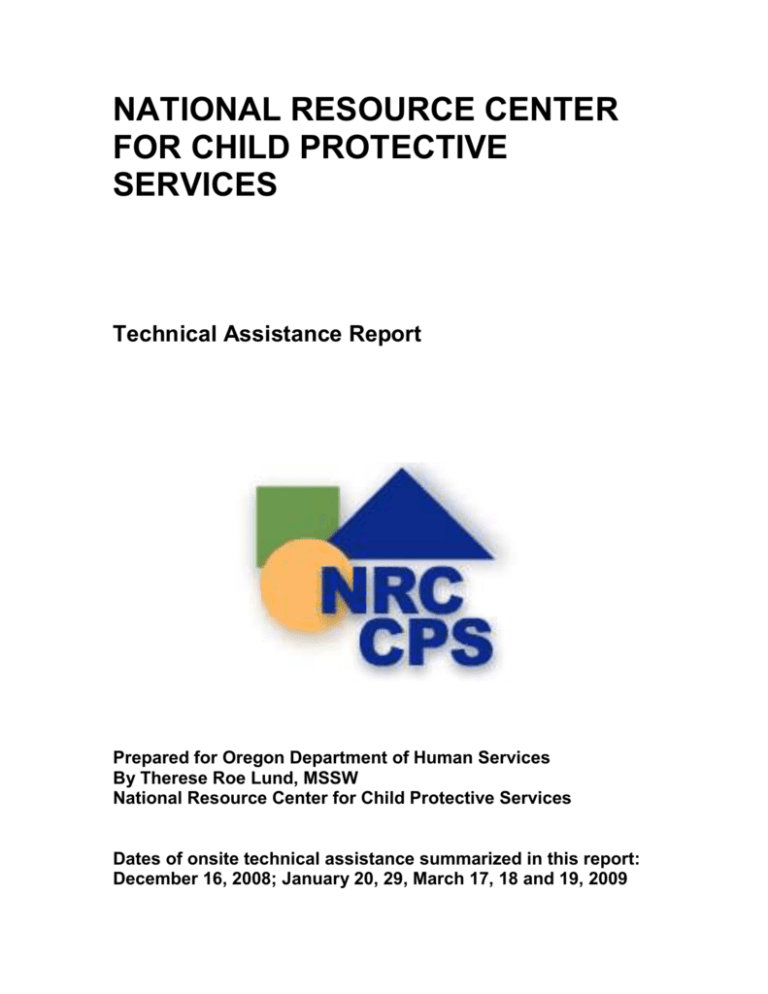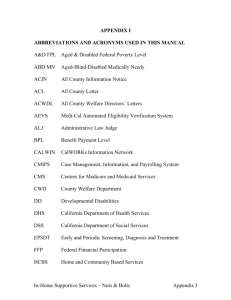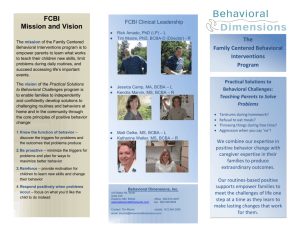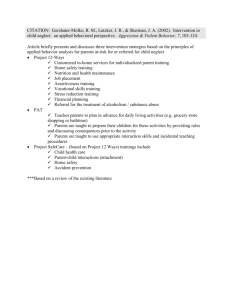Technical Assistance Report
advertisement

NATIONAL RESOURCE CENTER FOR CHILD PROTECTIVE SERVICES Technical Assistance Report Prepared for Oregon Department of Human Services By Therese Roe Lund, MSSW National Resource Center for Child Protective Services Dates of onsite technical assistance summarized in this report: December 16, 2008; January 20, 29, March 17, 18 and 19, 2009 Please indicate which responses were employed in this T/TA: __x__ ____ __x__ ____ ____ __x__ ____ ____ __x__ Technical Assistance Training Phone Consultation Referral to another NRC Referral to Other Organization Review of Policy and Materials Publications Provided Secondary Research Other/Group Facilitation Situation and Technical Assistance Request As a result of a comprehensive process to develop strategies for its Program Improvement Plan, Oregon has requested technical assistance from the National Resource Center for Child Protective Services along with the National Resource Center for Family Centered Practice and Permanency Planning, and the National Resource Center on Organizational Improvement. With the help of the Federal Regional Office staff and Oregon state staff, a matrix approach to prioritizing and assigning responsibilities for key strategies has been developed. The NRCCPS is assisting Oregon with improving its processes for group decision making, to ensure consistency with its safety model. NRCCPS is also collaborating with NRCFCPPP on improving in-home services and both resource centers are joining as needed with NRCOI to help with improving clinical supervision. Technical Assistance Provided Regarding Group Decision-Making: onsite visits December 16, 2008, January 20 and March 17, 2009 An initial meeting was planned for December 16 to identify the issues regarding group decision making processes in Oregon and to begin to form an idea of the level of effort needed to carry out tasks. Weather proved to be disruptive; after Terry Roe Lund from NRCCPS arrived in Portland, most of the state was overcome by a snow/ice storm. Therefore, a few staff people participated in a teleconference call with Terry Roe Lund on December 16. A short history was provided of the various group meetings Oregon has for case review/decisionmaking. Materials were identified that would be useful for Ms. Roe Lund to review prior to a next visit. January 20, 2009 was the actual first face to face meeting Terry Roe Lund from NRCCPS had with Oregon staff. A discussion around the various group decision making requirements revealed the following: Just as stated in Oregon’s PIP, the focus should be how the various group decision making processes need to be adjusted to be consistent with Oregon’s Safety Model. Rather than focusing on the issue of “who can facilitate these meetings” the group was encouraged to use their own model to focus their examination on the group decision making processes. o What is the purpose of each group decision making meeting? o Where would that purpose fit within the case process/decision making point? o How does the group meeting’s protocol and criteria for decisions mesh with the criteria Oregon uses for decision making outside of a group meeting? When a strong advocate for continuing these meetings as they currently exist expresses resistance to change, the group was encouraged to examine what the advocate believes he/she gets out of the meeting. Look within the case process/decision making points and demonstrate how/when this information can be gathered and made available. For example, if a judge believes a meeting (held in the court hall shortly before the hearing) should not be revamped, translate what the judge actually wants into clearer direction for staff: o What must be known/discussed by the court hearing includes: The alleged maltreatment and surrounding circumstances The interviewing protocol thus far The present danger (in detail) observed The protective action (in detail) taken Options available and considered for protective action Any emergency needs of the family Next steps to be taken by CPS with time estimate Others’ concerns, agreement Next court date Initial impressions are that there are too many purposes currently for the Child Safety Meeting. Separating this meeting from the business of transferring the case is advised Consideration by the group was given to the PIP timeframes for accomplishing their goals for group decision making. Considerable discussion was also held regarding how to implement a change effort: who should be involved; are the current members of this discussion the right ones. In addition, implementation of changes to their group decision making processes will require systemic support. Discussion of the need for policy, supervision, measuring for the changes desired, etc. would all help achieve the change they desire. The group agreed to a return technical assistance visit with a newly formed group of “experts” with the necessary sanction to work on improving group decision making processes. In addition, the new group would meet before the next TA site visit to continue the process of examining each group meeting’s purpose, and comparing that to where it should fit in the case process and associated criteria for decision making. The next on-site technical assistance visit was held on March 17, 2009. Terry Roe Lund from NRCCPS met with a group of 16 managers to expand the discussion of group decision making in Oregon. Most of the managers had not been present at the January site visit and this was the first gathering of the new group. Thus, context for coming together was necessary to provide, along with the need for group members understand the need to remain involved in this process. The following was decided at this meeting after considerable discussion: There will be a transfer meeting (from initial assessment to ongoing) outside of and prior to the Child Safety Meeting Jan Slick will write up a draft policy for members to consider The group is leaning towards requiring the 2 workers and the 2 supervisors to attend this meeting The group is leaning towards the need for the answers to the 6 domains to be written up. Currently there is no format (automated or on hard copy) for this requirement. As such, cases have little information about the family. The group is considering piloting this, to help work out problems with the process, acquire better understanding of what it will take to support the requirement. The group will meet to discuss the current need for group decision making meetings, trying to use the Oregon Safety Model as its compass rather than the “way things are.” An example for how the group might focus was provided during the site visit: 1. Consider the purpose for the meeting. If stuck on whether a meeting is designed to “confirm” or “determine” a safety decision, reflect on the purpose this task is in the PIP. It is an effort to improve the engagement of families. 2. Therefore, consider refining the purpose of the meeting to be: the engagement of the family in the management of their children’s safety 3. The assumptions that lie beneath this newly stated purpose are: a. CPS involvement is intrusive b. CPS families are involuntary c. Knowledge is empowering d. Ethically we have a responsibility to hold ourselves accountable for the level of effort and quality of engaging the family e. Families have more of an investment than do strangers in sustaining plans to ensure safety of their children/kin f. While certain fundamental issues may not be negotiable CPS should hold itself accountable for an open, transparent and creative problem-solving and decision-making process 4. Decisions to be made for a meeting with this type of purpose: a. Who comes to this meeting, who invites, how is it done, how much lead time is given b. What information is the worker prepared to discuss c. What information is the family prepared to discuss and who prepares the family for this meeting d. Whose case is it at the end of the meeting e. What are the next steps that can be identified and scheduled before the meeting adjourns f. What is the expectation for case materials being ready (for the next worker) The meeting adjourned with no plans for further technical assistance. The group will continue to meet to make the types of decisions discussed during this site visit. Regarding In-Home Services: onsite visits January 29, and March 18 and 19, 2009 On January 29, 2009, Terry Roe Lund from NRCCPS accompanied Janyce Fenton from NRCFCPPP to an onsite visit with Oregon DHS staff to discuss their request for technical assistance for their delivery of in-home services. A meeting was held with agency administrators to engage in discussion regarding the meaning of the agency’s PIP strategy regarding in-home services and the implication any refinement of their in-home program will have on other program areas. Ms. Fenton provided some overview of model development with the intention to seek some consensus regarding what Oregon sees as its needs for a comprehensive in-home component to its child welfare program. The meeting with top administration was adjourned, and further discussion was held with key managers for this PIP strategy, including the agency’s PIP coordinator. In an effort to gauge the current status of the in-home program in Oregon, it was determined that many issues remain unknown. Practice is quite varied throughout the state. Some offices have dedicated staff for in-home services while others do not (and some cannot due to size). While the CFSR certainly gave feedback, the agency’s managers do not have a good impression of the degree of variation regarding in-home services related to: Adequacy of safety management of in-home cases Correct identification of which families receive in-home services Quality of engagement of families Family participation in case planning and safety management What systemic influences are challenging and are positive regarding inhome service delivery It was agreed that a small case reading sample of in-home services would be helpful to “take the pulse” of the status of in-home service delivery; identify what is influencing the current status; and developing strategies to help refine/improve Oregon’s in-home service delivery. In addition, technical assistance was requested to help with the case review to help build capacity among Oregon’s program management staff to replicate this type of examination for other types of issues in the future. Two days were scheduled in March for this review to take place, with the record reading instrument to be developed by Terry Roe Lund from NRCCPS. Due to Ms. Fenton’s schedule, the record reading would be conducted without her assistance, but she would join the remaining technical assistance (if any) in the future. The remaining portion of the day was spent with Jan Slick and 10 private providers of services for Oregon DHS. Oregon intends to take the current funds used for Family Based services and in the future issue Requests for Proposals for services to keep children safely at home. Discussion with the service providers was for the purpose of ensuring understanding of the differences between change oriented services (more of what is done now) and safety services. Issues of needing services to be immediately accessible, often concrete services, tasks and actions were stressed as necessary for safety management. Examples were provided of safety services. Ms. Fenton and Ms. Roe Lund encouraged the group to identify what will be needed by providers to make this shift in role and service delivery in order to carry out this new charge. Ms. Roe Lund will send Jan Slick examples of language to place in the RFP and/or contract and/or performance measures in order for Oregon to successfully transition its service provider community to a safety management orientation. Case Record Reading On March 18 and 19, Terry Roe Lund from NRCCPS met with 10 Oregon DHS program staff to conduct a case record review of in-home services cases. The record reading instrument, along with some practice requirements from Oregon’s Safety Model were reviewed by the group with discussion to ensure understanding of the purpose of the review: simply to record what is happening and then analyze, as a group, any trends, impressions and observations of what seems to influence practice. This “reality check” of in-home services in Oregon along with an analysis of what seems to influence the reality encompassed a review of cases that were: referred to in-home services after an initial assessment (N=29) referred to in-home services after a reunification from foster care (N=28) served for at least 6 months in in-home services and closed (N=35) Impressions from the Record Reading The majority of the records reviewed were not truly “in-home services” cases. Sometimes this was due to a coding by the assessment worker that in-home services were being provided and thus the case was identified wrongly for the pool. Other cases were not “in-home services” cases due to the child not living in the home with the caregiver originally involved; the child had moved (through CPS involvement) to another caregiver (where no safety threats existed) or with another relative (where no safety threats existed). A total of 92 cases were looked at by the review team. Only 40 fit the category of “in-home services.” This lack of clarity about what constitutes an “in-home case” fits the trend noted by CFSR teams nationally when attempting to review in-home cases. Information Collection While sometimes a great deal of information was contained in the record, most of the cases had information that was not pertinent to understanding the family and not informative regarding safety management responsibilities. The group of reviewers found information to be superficial. Adult functioning and Parenting domains were particularly lacking in information. Family engagement and participation Interaction with the family, when it could be determined, reflected an authoritarian and sometimes disrespectful approach. Plans (safety or case plans) were sometimes quite intrusive. Fathers/boyfriends were often not involved in any aspect of the casework, including the gathering of basic information. The group speculated whether cases that are deemed appropriate for in-home services are based on the passivity or how “nice” parents might be. This issue warrants further examination. Safety Management While it was clear in some cases that staff were trying to use safety concepts in their work, the loss of focus on safety overall was apparent in most if not all the cases reviewed. In cases transferred to in-home immediately from assessment, the group found that only 1/3 of the cases had a sufficient safety plan to manage the threats. Safety threats were sometimes misidentified; they were not behaviorally described; they were not tied to conditions for return (on the reunification cases reviewed). Safety plans often amounted to caregiver promises or had treatment services rather than safety services. Changing Behavior: Case Plans Many case plans tried to incorporate the language from Protective Capacity Assessment training. As a result, however, it was classroom training manual language rather than individualized strategies for how a particular parent would enhance particular behaviors, etc. to improve his/her capacity to protect. Progress seemed to be measured by compliance with services; little description of behavioral change was found in the records. Monitoring was often the primary activity (at least recorded) by the worker. Summary of Impressions The lack of focus for in-home work is most transparent from the case review. The reviewers noted that the front end assessment work’s approach was incident based with a lack of comprehensive information and therefore poorly justified safety decisions. This approach spills over to in-home service delivery. The approach from the front-end seems to influence what happens in ongoing. The Oregon Safety Model should provide a framework for examining how to better reinforce the roadmap for in-home service workers to follow. Training, and even frequent refresher training, will not suffice. The systemic supports from leadership (defining the vision of what is in-home services in Oregon and directing the change effort), policy/procedure, supervision, documentation, professional development, and quality assurance (that is, measuring fidelity of implementation benchmarks) must all work in sync to prepare for a better defined and implemented in-home services program. The scope of this work to redefine and systemically support in-home services must be examined by DHS to determine if this is the change effort they wish to pursue at this time. Alternative approaches which still remain consistent with their PIP strategy regarding in-home services improvement may be an avenue the agency wishes to explore. Finally, the reviewers have the more complete list of each trend and observation made from the record review, rather than this report’s summary. The process of an expert review for such an analysis could and should be within the agency’s capacity to replicate. Next Steps No further technical assistance is scheduled at this time pending further discussion and decision making by DHS and likely through future scheduled teleconference calls.








